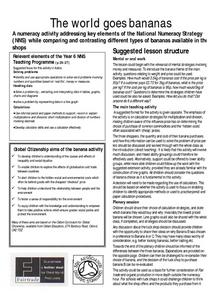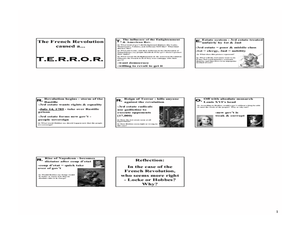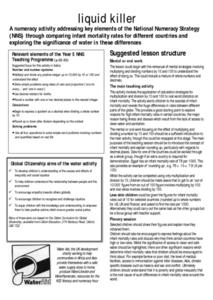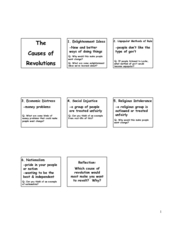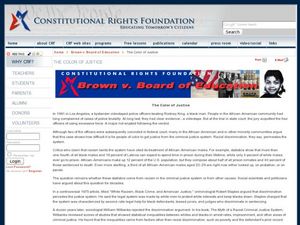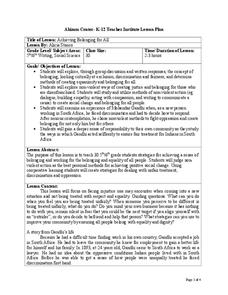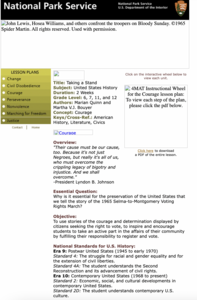Museum of Tolerance
The Pursuit of Democracy and Diversity: The Trial of Pro-Social Injustice in Historical Documents and Accounts
Class members investigate The Indian Removal Act of 1830, U.S. Theft of Mexican Territory Timeline, and President Abraham Lincoln’s letter to Horace Greeley, 1862, and then conduct a mock trial of each of these documents to determine...
Just Health Action
Causes of the Causes: What Are the Root Causes of This Problem?
A "Causes of the Causes" diagram enables class members to examine the contributing factors to a problem. After reading a poem that models the process, class members, either in gorps or individually, diagram an issues they are passionate...
Curated OER
Religion in Social Change: What's God Got To Do With It?
Young scholars determine how religion influences social change. In this religion and social change lesson, students examine how the religious beliefs of Mohandas Gandhi and Martin Luther King, Jr. were inspirational as they worked to...
Curated OER
The World Goes Bananas
Learners comprehend the causes and effects of inequality and social injustice. They explore the effects of globalization and trade between countries. Students discuss the hidden social and environmental costs which often lie behind goods...
PBS
Sitting Bull: Spiritual Leader and Military Leader
Sitting Bull was not expected to be a great warrior. Yet, he led the Lakota people and other tribes to several pivotal victories against the United States government when federal troops threatened their land. Using primary sources, such...
Curated OER
Claudette Colvin: Twice Toward Justice
Use the historical account of Claudette Colvin to study civil rights and connect past injustices to modern issues. As learners read, they examine chapter titles, record quotes, and participate in discussion. Next, they research active...
Curated OER
The French Revolution caused a... T.E.R.R.O.R.
In this French Revolution study guide worksheet, learners read a brief overview pertaining to the time period in French history and then respond to 10 reflection questions.
Curated OER
Liquid Killer
Students explore number sense applications and discuss strategies for multiplication and division using mental math. For cross-curricular purposes, they explore causes and effects of inequality and social injustice. Students explore...
Curated OER
American Jews and Civil Rights
Tenth graders examine the Civil Rights movement of the 1960's and how American Jews were involved. They discuss the responsibilities of any minority or ethnic group. They consider the process of change in politics as well.
Curated OER
An Introduction to the Season for Nonviolence
Fourth graders create a Venn diagram and a cause and effect graphic organizer on Gandhi and King. In this non violence lesson plan, 4th graders compare the two non violent leaders and discuss and articulate non violent protests and write...
Curated OER
Philanthropy and You
Learners identify human rights and study the values of historical figures who fought for human rights. In this human rights lesson, students define the term human rights and research examples of human mistreatment in history. Learners...
Curated OER
The Causes of Revolutions
In this history of revolutions study guide worksheet, students read a brief overview pertaining to Enlightenment ideals and then respond to 7 reflection questions.
Curated OER
A Never-Before-Seen Creature
Students construct a never-before-seen creature in part of an analysis of societal injustices and discrimination. In this societal issues lesson, students create a creature called a Man-Droid as a study about the differences among...
Museum of Tolerance
Essential Vocabulary and Concepts
Genocide. Scapegoat. Propaganda. Words are powerful. Words carry the weight of history. To prepare for a visit to The Museum of Tolerance, class members consider the weight of meaning in words related to intolerance.
PBS
Racial Equality: How Far Have We Come and How Far Do We Have To Go?
Is everyone treated fairly in America? The culminating fifth lesson from a series of five has pupils explore racial inequalities from the 1960s and decide whether or not society has changed over time. The lesson comes with a speech from...
Curated OER
The Color of Justice
Students analyze racism and justice. In this legal system discrimination lesson, students listen to their instructor lecture on disparities in the legal system. Students respond to discussion questions following the lecture and evaluate...
Curated OER
A Picture: Worth One Thousand Words?
Students examine photographs from the Civil War. Using a primary source document, they discover the conditions of a private during the Battle of Chickamauga. In groups, they use the sources to determine the authnecity of the documents.
Curated OER
Achieving Belonging for All
Students explore ways of belonging. For this social science lesson, students discover non-violent ways for belonging similar to Mohandas Gandhi.
Curated OER
Do the Write Thing
High schoolers take stands on issues that matter to them. For this philanthropy lesson, students read Anne Frank: The Diary of a Young Girl, discuss the act of advocating for others, and write letters of support for issues they belive in...
Curated OER
A Billion Hungry People
Students discover the inequality of food distribution. In the hunger lesson, students discuss how some places and people do not get the food they need to survive. Students role play distributing pretend meals to people (of unequal...
Curated OER
Modern Advocates for Change
Learners make a list of "modern day prophets" and explain how they have made considerable contributions toward the common good. They write a letter to a community leader in which they advocate the solution to a problem or issue in their...
Curated OER
Taking a Stand - 1965 Selma-to-Montgomery Voting Rights March
Young scholars examine the 1965 Selma-to-Montgomery Voting Rights March. They view pictures reflecting their perceptions of their most important rights as citizens, write journal responses, create collages illustrating courage, and read...
Curated OER
Not the Stereotypical Immigrant?
Students complete a Venn diagram comparing the stereotypes of modern African immigrants to those of other major immigrant groups in the U.S. They write an essay on their observations.
Curated OER
US Constitution And Federal/State Relationship
Learners examine the Constitution for references to the relationship between state and federal governments. They examine Supreme Court cases for examples of the division of government between state and federal powers.





